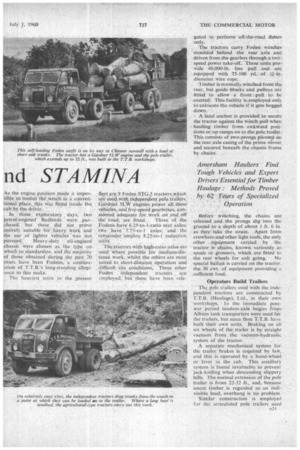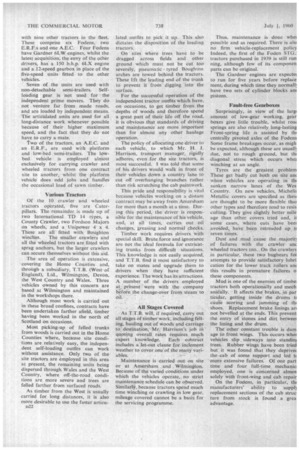Timber Work Needs Skil
Page 86

Page 87

Page 88

If you've noticed an error in this article please click here to report it so we can fix it.
nd STAMINA STEAM traction still has its adherents. Mr. J. R. Dickens, foreman fitter of T.T.B. (Haulage), Ltd., Amersham Common, Bucks, is one. The company are one of the largest hauliers in the country to be occupied solely with the carriage of timber, and used steam vehicles exclusively up to 1937. Their last steam wagon was retired as late as 1944.
I suggested, innocently, that steam vehicles declined because of their low speed. Mr. Dickens denied this and wistfully recalled that the company's last Foden Speed Six would exceed 40 m.p.h., and could travel to Birmingham and back in a day. Indeed, this vehicle was faster than some of the oil-engined tractors in present use.
1320 For timber haulage, the low-speed torque of the steam vehicle was ideal, and its relatively high unladen weight assisted winching under difficult offthe-road conditions. The demise of steam for this work is solely attributable to the remOval of waterreplenishment points from the roads, and the difficulty of providing facilities for taking on solid fuel.
T.T.B. (Haulage), Ltd., as a separate concern, came into being some three years ago, but the parent company, T. T. Boughton and Sons, Ltd., who now manufacture winches and associated equipment, have been hauling timber since 1898. In 1937, when the change-over to oil-engined vehicles began, eight steamers were in use.
During the second world war. expansion was rapid until, in 1948, some 20 vehicles were employed. From that time, the status quo has been maintained, the present fleet consisting of 19 independent and articulated tractors.
The first oil-engined vehicle obtained was an A.E.C. tractor, and at about the same time a hybrid Foden was put into service. The Foden marked the manufacturers' transition, in forestry tractors at least, from steam to oil power.
Basically, it employed the existing steam-vehicle chassis and axles but had a Gardner 5LW engine mounted transversely above the frame behind the cab, with primary drive by chain. As the engine position made it impossible to mount the winch in a cOnVerttional place this Was fitted inside the cab by the driver. .
In those exploratory days, two petrol-engined Bedfords Were pur-. chased, but these. did riot prove. entireIY suitable for 'heavy *Ork and the use of lighter vehicles was not pursued. Heavy-duty oil-engitted chassis Were chosen as the type on which to standardize, and the majority of those obtained during the past 20 years have been Fodens, a continuation of T.T.B.'s long-standing allegiance to this make.
The heaviest units in the present
fleet are 9 Foden STG.5 tractors which are Used with independent pale trailers, Gardner 50/i/ engines power all these vehicles, and five speedgearboXes, conrsidered adequate for work on and off the road, are fitted. Three • of the .Fodens have 6.25-to-1-ratio rear axles; two have— 7.75-to-1 axles; and the remainder -employ 825 to 1 reduction units.
The tractors with high-ratio axle are used where possible for aiedium-diS-, Lance work, whilst the others are most suited to short distance Operation and , difficult site conditions, Three other Foden independent tractors ace employed, but these have been rele
Before winching, the chains are released and the prongs dig into the ground to a depth of about I ft. 6 in. as they take the strain. Apart from crowbars and-other light tools, the only other equipment carried by the tractor ischains, knowa variously, as . spuds or grousers, which are fitted to .-the rear Wheels for soft going. No 'special ballast is carried on the tracteir, • the: 30 cwt. of equipment providing a .sufficient load: Operators Build Trailers
' The pole trailers used with the independent tractors are constructed by T.T.B. (Haulage), Ltd., in their own • workshops. ln the immediate postwar period tandem-axle bogies from Albion tank transporters were used fir the trailers, but since then T.T.B. have built their own units. Braking on all six wheels of the trailer is by straight vacuum from the vacuum-hydraulic system of the tractor.
A separate mechanical system for the trailer brakes is required by law, and this is operated by a hand-wheel or lever in the cab. This auxiliary system is found invaluable to prevent jack-knifing when descending slippery • hills. The normal extension of the trailer is from 22-32 ft., and, because uncut timber is regarded as an indivisible load, overhang is no problem. Similar construction is employed for the articulated pole trailers used with nine other tractors in the •fleet. These comprise six Fodens, two E.R.F.s and one A.E.C. Four Fodens have Gardner 6LW engines, whilst the latest acquisition, the envy of the other drivers, has a 150 b.h.p. 6LX engine and a 12-speed gearbox in place of the five-speed units fitted to the other vehicles.
Seven of the units are used with non-detachable semi-trailers. Selfloading gear is not used for the independent prime movers. They do not venture far from made roads, and are loaded by independent means. The articulated units are used for all long-distance work whenever possible because of their higher maximum speed, and the fact that they do not have to carry a mate.
two of the tractors, an A.E.C. and an E.R.F., are used with platform and low-bed semi-trailers. The lowbed vehicle is employed almost exclusively for carrying crawler and wheeled tractors from one contract site to another, whilst the platform vehicle does odd jobs and handles the occasional load of sawn timber.
Various Tractors Of the 10 crawler and wheeled tractors operated, five are Caterpillars. The remainder is made up of two International TD 14 tYpes, a County Crawler, two Fordson Majors on wheels, and a Unipower 4 x 4. These are all fitted with Boughton winches. The sinaller crawlers and all the wheeled tractors are fitted with sprag anchors, but the larger crawlers can secure themselves without this aid.
The area of operation is extensive, covering the Home Counties and, throtigh a subsidiary, T.T.B, (West of England), Ltd., Wilmington, Devon, the West Country and Wales. Three .vehicles owned by this concern are based at Wilmington and maintained in the workshops there.
Although most work is carried out in these broad confines, contracts have been undertaken farther afield, timber having been worked in the north of Scotland on occasions.
Most picking-up of felled trunks from woods is carried out in the Home Counties where, because site conditions are relatively easy, the independent self-loading outfits can work without assistance. Only two of the site tractors are employed in this area at present, the remaining units being dispersed through Wales and the West Country, where off-the-road conditions are more severe and trees are felled farther from surfaced roads.
As timber from the West is usually carried for long distances, it is also more desirable to use the faster articu D22 lated outfits to pick it up. This also dictates the disposition of the loading tractors.
On sites where trees have to be dragged across fields and other ground which must not be cut too severely, pneumatic tyred Boughton arches are towed behind the tractors. These lift theleading end Of the trunk to prevent it from digging into the surface.
For the successful operation of the independent tractor outfits which have, on occasions, to get timber from the depths of woods and therefore spend a great part of their life Off the road, it is obvious that standards Of driving and maintenance are more important than for almost any other haulage operation.
The policy of allocating one driver to each vehicle, to which Mr. H. J. Harrison, transport manager, .rigidly adheres, even for the site tractors, is most successful. I was told that sonic of his drivers would walk in front of their vehicles down a country lane to cut off 'overhanging branches rather than risk scratching the cab paintwork.
This pride and responsibility is vital because vehicles working on a distant contract may be away from Amersham for more than a month at a time. During this period, the driver is responsible for the maintenance of his vehicle, and, at all times, carries out oil changes, greasing and normal checks.
Timber work requires drivers with special skill. Brute force and ignorance are not the ideal formula for extricating trunks from difficult situations. This knowledge is not easily acquired, and T.T.B. find it most satisfactory to take on mates and upgrade them to drivers when they have sufficient experience. The work has its attractions. A .number of the drivers employed
present were with the company before the Change-over from steam to oil. • .
All Stages Covered As T.T.B. will, if required, carry "out all stages Of timber work, including felling, hauling out of woods and carriage to 'destination; Mr.' Harrison's job in quoting overall, rates requires much expert knowledge. Each coritract includes a let-out clause for inclement weather to cover one of the many variables.
Maintenance is carried out on site or at Amersham and Wilmington. Because of the varied conditions under which the vehicles operate, no strict maintenance schedule can be observed. Similarly, because tractors spend much time winching or crawling in low gear, mileage covered cannot be a basis for the servicing programme. Thus, maintenance is done whet possible and as required. There is als( no firm vehicle-replacement policy Indeed, the first of the Foden STG.. tractors purchased in 1939 is still run fling, although few of its comporien parts can be original.
The Gardner engines are expecte( to run for five years before replace ment, during which time they normalb have two sets of cylinder blocks am pistons.
Fault-free Gearboxes
Surprisingly, in view of the largl amount of low-gear working, gear boxes give 'little trouble, whilst roac springs arc also relatively long-lasting Front-spring life is assisted by fill centrally pivoted axles of the Fodens Some frame breakages occur, as migh be expected, although these are usualb due, not to rough ground, but th■ diagonal stress which occurs whet winching at an angle.
Tyres are the greatest problem These get badly cut both an site an when vehicles are operating in thl sunken narrow lanes of the Wes Country. On new vehicles, Michelit Metallic covers are specified as thes( are thought to be more flexible that other types and therefore tend to resis cutting. They give slightly better mile age than other covers tried and, it some cases, where cuts have beet avoided,, have been retreaded up. t(
seven times. .
Dust and mud cause the Anajorit] of failures with the crawler ant wheeled tractors too. On the crawlers in particular,' these two bugbears foi attempts to provide satisfactory lubri cation for the lower track rollers am this results in premature failures o these components.
Mud is one of the enemies of timbe, tractors both operationally and mech anieaLly. It affects the' brakes, in par ticiflar, getting inside the drums t( caue scoring 'and jamming of till shoes. Replacement brake linings an not bevelled at the ends. This prevent the entry of stones and dirt betweer the lining and the drum.
The other constant trouble is dam age to front wings. This occurs whet vehicles slip sideways into standim trees. Rubber wings have been tried but it was found that they' deprivec the,cab of some support and led t( more extensive failures. Of one part time and four full-time mechanic employed, one is concerned almos solely with front-wing and cab repair
On the Fodens, in particular, thi manufacturers' ability to suppb replacement sections of the cab struc ture from stock is found a grea advantage.




























































































































































